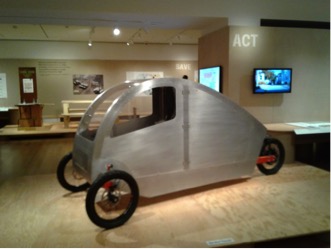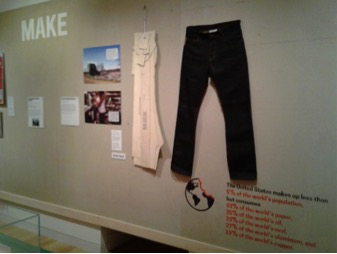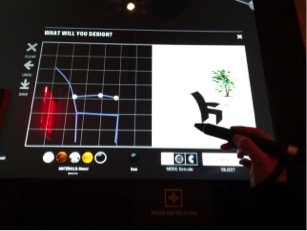By the People: Designing a Better America

By the People: Designing a Better America
Cooper Hewitt, Smithsonian Design Museum
September 30, 2016 – February 27, 2017
By the People: Designing a Better America was the third installment of the Cooper Hewitt’s Socially Responsible Design exhibition series, succeeding Design for the Other 90% in 2007 and Design with the Other 90%: Cities in 2011. It included sixty small-scale, grassroots projects that address problems in some of the most economically fragile parts of the U.S. today: rust-belt cities, post-industrial rural landscapes, areas damaged by natural disasters, and border regions.
This exhibition was the culmination of curator Cynthia E. Smith’s research, for which she travelled fifty thousand miles in over two years to meet with project creators and users. She included stirring examples of collaborative projects: a zero-emission hybrid bicycle-car, models of correctional facilities made by incarcerated people, a portable agricultural classroom, and water stations on the Arizona-Mexico border, to name a few. In addition to large-scale projects, original objects also presented intervention strategies, such as designer Alfred Twu’s High Speed Rail Board Game, which gives its users the tools to reconfigure the United States’ transportation infrastructure and imagine a different reality.

Smith did not set a path for visitors to follow through the exhibition, which occupied the entire top floor gallery of the museum. Rather than fit the installations into her own narrative, the curator let them stand alone, allowing the projects’ creators to speak for themselves, further underlining the democratic intentions of the exhibition. While each installation had its own wall text, Smith scattered statistics about poverty and resource overconsumption along the gallery walls, addressing two realities that the featured designs aimed to reverse. The prominent words “SHARE, “ACT,” “MAKE,” and “SAVE” thematically divided the exhibition, and Smith gave voice to project participants by including large-print quotations from them on the surrounding walls. One participant remarked on their Nuestra Lugar[1] Productive Public Space and Biciteca Bikeshare in North Shore, Eastern Coachella Valley, California: “[b]efore I started the park project and the transportation project, I didn’t know a lot of people in North Shore. I also didn’t know my own potential to change my community.” This statement provided one example of how such projects do not only tangibly shape the environment but also strengthen communities. However, despite Smith’s clear effort to center the exhibition on participants’ viewpoints, she did seek out and choose the projects on display, which influenced visitors’ understanding of contemporary community-based design in the U.S.

Furthermore, the significant number of projects from Black, Latino, Native, working-class, and poor communities suggests that these are the demographics most impacted by economic disparity, environmental disasters, and climate change, and that a one-size-fits-all approach to design is insufficient. The exhibition’s focus on user feedback, such as students’ written and drawn scenarios as part of a gun-violence prevention program, and user-friendly technologies—Text4baby, a free app that delivers tips on infant care to new parents—demonstrated the wide variety of ways and places in which we interact with design today. One powerful effect of this exhibition was the blurred line created between “designer,” “participant,” and “user,” since many of the projects on display were collaborative and evolved over time with the feedback of users. Smith in fact uses the term “participant” as frequently as “user,” suggesting that these projects give individuals more agency. These projects are meaningful not just in terms of outcome but largely through their creative processes.

Nuestro Lugar designers: Chelina Odbert, Jennifer Toy, Jessica Bremner, Shannon Scrofano, Evelyn Serrano, Kounkuey Design Initiative; Collaborators: Desert Recreation District, North Shore Leadership Committee, Residents of North Shore; Biciteca Bikeshare program designers: Jessica Bremner, Carlos Hernandez, Kounkuey Design Initiative; Valentin Paredes, Zachary Camarena, Issac Camarena, Desert Riderz. Photo courtesy of the author.
Visitors were drawn further into the exhibition by Cooper Hewitt’s “Pen” device, which could be used to save individual projects to a personal online database for later viewing. Additionally, the Pen allowed visitors to create and save their own designs on one of several touch-screen computers in the gallery. By bringing these projects together, and including interactive digital design, Smith’s exhibition questioned who could be a designer and encouraged visitors to take what they had learned back to their own communities. By presenting sixty local solutions to specific problems alongside facts about economic and environmental crises, By the People demonstrated that design is not just an aesthetic approach but also an intervention strategy to provide solutions to socioeconomic inequalities in the U.S. today.

Lydia Harrington
[1] “Our place” in Spanish.